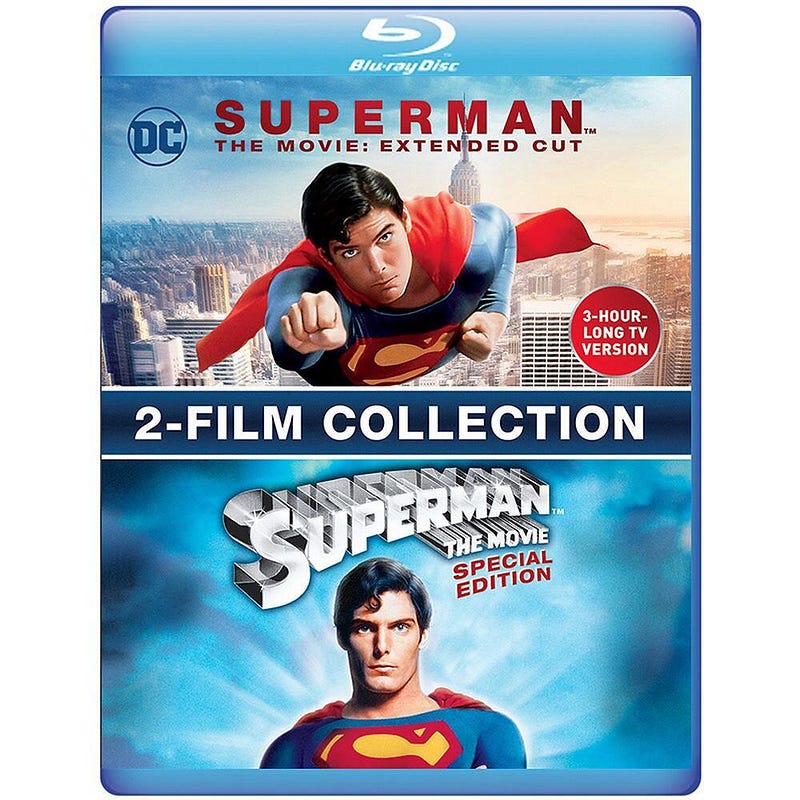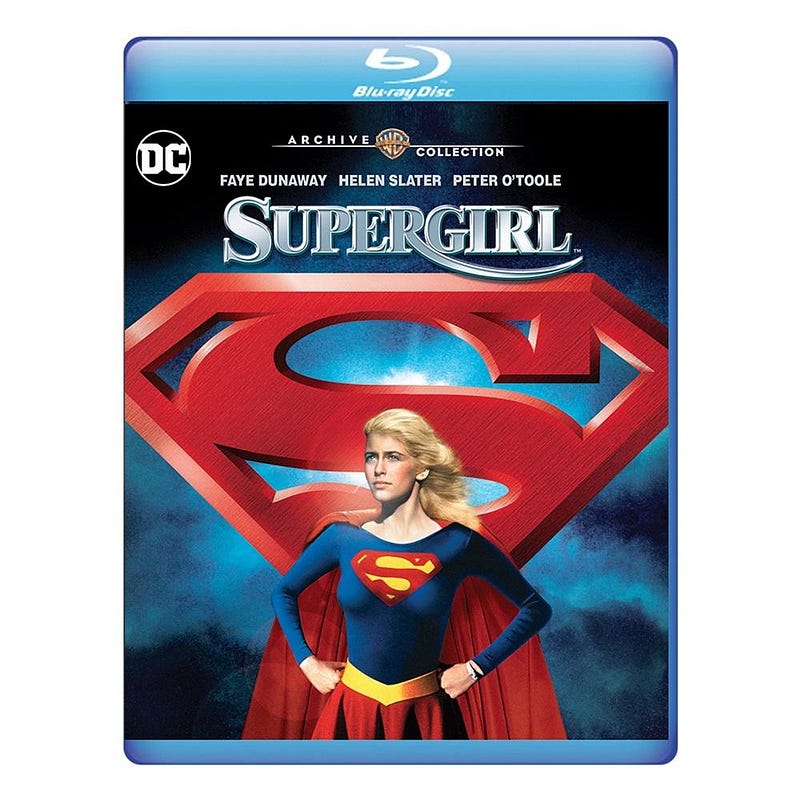More DC Superpicks from the Warner Archive Collection

The Archivist — Welcome to the Archive. As home video formats have evolved over the years, a multitude of films have found themselves in danger of being forgotten forever due to their niche appeal. Thankfully, Warner Bros. established the Archive Collection, a Manufacture-On-Demand DVD operation devoted to thousands of idiosyncratic and ephemeral works of cinema. The Archive has expanded to include a streaming service, revivals of out-of-print DVDs, and factory-pressed Blu-ray discs. Join us as we explore this treasure trove of cinematic discovery!
In the last edition of The Archivist, Justin took us on a tour of DC television ephemera preserved on DVD with Shazam! and Legends of DC Superheroes.
“Part 2” in our look back at classic DC Superheroes moves on from the now-obscure pockets of TV wackiness to the big screen with Superman (in its Extended TV edition) and Supergirl, both available on Blu-ray from the Warner Archive.

SUPERMAN: EXTENDED CUT (1978)
Warner Archive’s edition of Superman: The Movie, released last year, features the previously rare 3-hour Extended Cut, originally created for television.
These days we have a lot of amazing comic book movies being produced every year, but 1978’s Superman and its immediate followup Superman II were the gold standard of comic book filmmaking for over a decade, until Tim Burton’s Batman hit in 1989.

The film heavily pushed its tagline, “You’ll believe a man can fly”, and special effects maestros spent millions on R&D and execution of bringing the Man of Steel to screens in a believable performance, which, combined with reverent storytelling, gentle direction by Richard Donner, and an all-timer of a John Williams score, contributed to a classic and beloved film.
With its even longer approach, the Extended Cut accentuates even further one of Superman’s most unique aspects — it takes its time. Clark Kent doesn’t arrive in Metropolis until about an hour into the film, and it’s not until the halfway mark, by which time typical films would be rolling their credits, that Superman makes his first public appearance.
Before Supes can appear, the film gives full weight to his Kryptonian origin and experience growing up as an adopted son, and then further explores his dual fatherhood — he’s raised with love by Jonathan Kent, but also shaped and challenged by his biological father Jor-El, who has gifted him with a sort of AI construct that retains his memories and wisdom.


But once he’s on the radar, Superman does heroic deeds, romances headstrong reporter Lois Lane (Margot Kidder), and grapples with the criminal Lex Luthor (Gene Hackman) and his goons. Luthor plans to detonate the San Andreas fault, sending the west coast plunging into the ocean — and turning the worthless deserts, which he has been buying up wholesale, into prime beach real estate. Hackman is great as the conniving mastermind, even if it’s a little difficult to believe he’d ally himself with such imbecilic helpers as Otis (Ned Beatty) and Ms. Teschmacher (Valerie Perrine).

The movie is far from perfect — You’ll never convince me that the “Can you read my mind?” sequence is anything but awful, and the penthouse scenes that bookend it are — apart from the great dialogue — rather silly. Even ignoring the noticeably fake set backdrops, I find it unbelievable that a reporter could afford a penthouse apartment with a walkout patio, in New York City, even in 1978 (I mean technically it’s Metropolis but we all know it’s NYC). And most famously, the film’s time-altering climax, besides making no sense, creates a massive narrative flaw —if Superman can turn back time and fix anything, what drama is left for his character?


But thanks mostly to incredible performances by Christopher Reeve — as Clark Kent and Superman — there’s a lot of goodness here as well. Superman is a true hero, and that shines brilliantly above any other flaws this film may have — they got his heart right. And that’s why we still love this movie 40 years later.

SUPERGIRL (1984)
Released after Superman III when the franchise was starting to show signs of decline (before Superman IV killed it outright in 1987), Supergirl, produced by the same team of Alexander and Ilya Salkind, is in many ways the most daring of the super-movies — but gets so much wrong that it’s ultimately a strange footnote for the storied franchise.
But that’s not to dismiss it too casually. While this is a spin-off of the Superman films, there are two very important, ambitious and commendable aspects to consider — Supergirl represents not only the first real effort to feature a female leading role for a superheroine, but also to expand a comic book Universe on film. While the jump from Superman to Supergirl is a very small one, it’s a groundbreaking first for modern superhero cinema.

We learn of a Kryptonian colony of survivors on Argo City, a space station of sorts, founded by Zaltar (Peter O’Toole) and kept in operation using magic, where resides Kara Zor-El (Helen Slater), the cousin of Kal-El, aka Superman. Zaltar is fond of the girl and acts as a mentor of sorts. Engaging in some mischief with the Omegahedron, the totem that powers the city, they accidentally send it off into space (to Earth), and Zaltar sends his apprentice to retrieve it and save the colony.

Supergirl tries to be both enough of “the same” and “different” to attract fans of the series while also doing its own thing, but doesn’t really pull off either very well. Unfortunately the connection to the franchise is pretty thin, and invites more criticism than credibility.

On Earth, the Omegahedron is found by Selena (Faye Dunaway), a nefarious witch who realizes its power and sets out to use it for her own purposes. Kara comes to Earth and assumes an identity as “Linda Lee”, enrolling in a private girls’ school where she quickly befriends one Lucy Lane, sister of Superman’s Lois. Around the same time, Lucy’s pal Jimmy Olsen (Marc McClure, reprising his Superman role, and the the only direct connection between the films) comes to town to visit. It’s against this backdrop that “Linda Lee” tries to recover the Omegahedron, and eventually confronts Selena.

From the synopsis alone, it’s not difficult to realize how staggeringly off-track this film gets. The major focus on magic, while not impossible in this Universe (banishment to the Phantom Zone might perhaps be another example), feels really off-putting and out of place for the established canon. And all the coincidental ties to the Superman films are so thinly constructed and poorly considered that they fall apart under even the most casual scrutiny — these among other plot holes. (The Omegahedron just happens to be found by a magic-capable witch? Why wouldn’t Superman, who can fly anywhere in the world in seconds, not visit his cousin, or vice versa? Is he aware there’s a colony of his people alive floating out in space? Why does Kara bother with enrolling in school, or establishing an alter ego? And seriously, why magic?)

Besides narrative nonsense, there’s also some generally questionable movie-making going on. Wires are plentiful and obvious in flying scenes, which is so antithetical to Superman’s famous tagline “You’ll believe a man can fly”. Also plentiful is an abundance of obvious product placement. This is something I usually don’t notice or care about, but it’s so blatant here that it’s impossible to miss. In other silliness, Selena and her sidekick live in a spooky carnival for some reason (what’s with that, 80s?), and a love potion figures prominently in the plot.

Supergirl is rightfully considered a terrible movie, so the real question that remains is whether it’s worthwhile on some other level. It’s certainly campy and weird, and historically significant in the history of comic book movies due to its universe-expansion and female lead, and I think those are all elements that could make it worthwhile for many viewers.
DC still hasn’t figured out the whole expanded cinematic universe thing by a long shot, but 2017’s Wonder Woman did it pretty successfully, and with a female character. Supergirl herself was successfully reintroduced into DC’s television universe beginning in 2015, as well as in animated form as part of the DC Superhero Girls line. As the character endures and finds new fans, I think this film will always be able to find an audience.

The Package — Superman: Extended Cut
This edition of the film is actually branded as a “2-Film Collection”, which I take great umbrage with. Let’s be clear: it’s just Superman, in two versions. The Extended Cut disc includes the 3-hour TV version of the film and is exclusive to this Warner Archive release. Also included is the “Special Edition” Blu-ray which is the common release of the film and includes bonus features.
It’s worth noting that Warner has just announced a 4K version of Superman to release in November, and for viewers who aren’t specifically interested in the Extended Cut (which I don’t think ultimately adds much to the film), I would advise to probably wait for that one.
Special Features and Extras
All special features are on the “Special Edition” disc.
- The Magic Behind the Cape (23:45)

- Making Superman: Filming the Legend (30:41)

- Taking Flight: The Development of Superman (30:14)

- Commentary by Director Richard Donner and Creative Consultant Tom Mankiewicz
- Deleted Scenes (14:29)
- Screen Tests (22:25)


The Package — Supergirl
The 2-Disc edition of Supergirl features the movie (“International Version”) on Blu-ray with a bonus DVD featuring the Director’s Cut of the film.
Special Features and Extras
- Commentary by Director Jeannot Szwarc and Special Project Consultant Scott Michael Bosco
- The Making of Supergirl (49:48) — vintage documentary

- Theatrical Trailer (2:35)
- DVD Only: Director’s Cut in SD (2:18:52)

A/V Out (for some Popeye’s Chicken and A&W Root Beer).
Get ’em at Amazon:
If you enjoy reading Cinapse, purchasing items through our affiliate links can tip us with a small commission at no additional cost to you.
https://cinapse.co/the-archivist-91-the-dc-superheroes-of-70s-television-visit-the-modern-age-7212260fef0ahttps://cinapse.co/the-archivist-91-the-dc-superheroes-of-70s-television-visit-the-modern-age-7212260fef0a
Except where noted, all 16:9 screen images in this review are direct captures from the disc(s) in question with no editing applied, but may have compression or resizing inherent to file formats and Medium’s image system. All package photography was taken by the reviewer.


